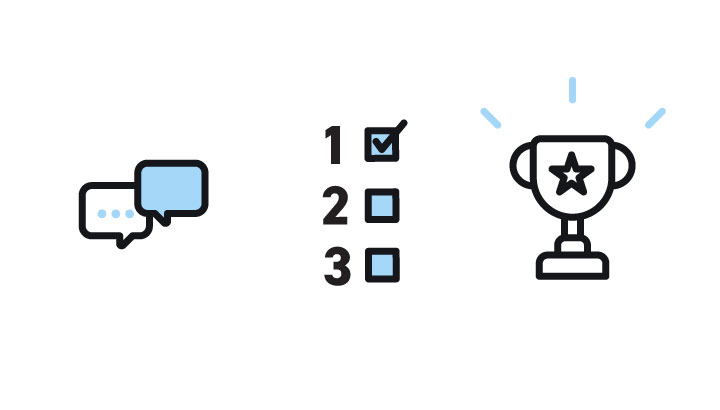2019 is the year of the talent shortage. HR Dive says the lack of qualified workers emerged as the number one risk factor for businesses this year. It is widely publicized as the top concern of Human Resources Managers across the United States.
But something isn’t adding up. CNBC reported recently that one-third of U.S. workers have given serious thought to leaving their jobs. Workers in 2018 left their jobs at the highest rate since 2001, which today would mean 3.5 million Americans decide to job jump every single month. Where are these candidates going and why aren’t they coming to you?
Is Your Talent Shortage an External or Internal Problem?

HR Managers everywhere are trying to figure out why they can’t seem to fill all the seats on their bus. Most blame the problem on external factors, like the historically low unemployment rate. But that doesn’t explain the 3.5 million people jumping ship each month.
It shouldn’t be surprising that people are leaving their jobs. Gallup has been regularly churning out reports that show 70% of workers are disengaged. A study in 2018 showed that 80% of full-time workers would be interested in a new job.
If you put the low unemployment numbers in a silo, it seems clear the reason you can’t attract talent is that there isn’t enough of it to go around. But when you start to look at the high volume of workers ready and willing to find greener pastures, the numbers don’t work.
HR guru Liz Ryan says flat out that the labor shortage is a myth:
“There's a talent shortage whenever employers complain that they can't find people with just the skills and the background they want, at exactly the price they'd like to pay. If I see a gorgeous vintage pearl-and-sapphire necklace in a magazine photo shoot and I can't find that same necklace on sale for $39.99 at T.J. Maxx, is there a necklace shortage?”
Oh, snap.
Ryan suggests that there isn’t a talent shortage, but that employers are seeking imaginary job skill combinations that don’t exist or they aren’t willing to pay for the experience that people have. And she’s not the only one to suggest that the talent shortage isn’t all it’s cracked up to be.
Labor Shortage? According to Jobvite, Not Exactly

Earlier this year, Jobvite conducted a study of workers around the country and declared that the job market is pretty much balanced in favor of candidates and not employers. But it’s the qualifier “pretty much” that they went on to explore.
While there are currently about a million more job openings than workers and tons of new entrepreneurial startups and initial public offerings (IPOs) on the horizon, Jobvite reviewed the numbers and agreed with Liz Ryan that something else is going on:
“Headlines can be misleading, and strong unemployment numbers don’t paint the full picture, leaving out an important part of the labor market: the one that is falling behind. While all signs point to tip-top job hunting conditions for American workers — where candidates negotiate salary more often, preemptively reject companies, and turn down signed offers in lieu of better ones — not everyone is able to find work and cash in on the bustling economy.”
The study suggests that the question, “How hard is it to find work today?” depends on who you ask. The Jobvite research showed:
- 45% of workers say it was harder to find a job this year over last year
- Rural workers say finding a job is much harder than it is for their urban counterparts
- Workers without a degree say it’s harder to find a job than it is for those with credentials
- Job seekers in mining, real estate, and transportation say it’s tough to find work
- While part-time workers and freelancers count as “employed,” 59% of them say they want a full-time role but can’t find it
Conversely, the study noted if you are a college-educated technology worker who is under the age of 30, the world is your oyster, job-wise. But according to the Jobvite study, it seems like employers are missing out on talent waiting in the wings to come on board.
Is it possible that the talent shortage isn’t as bad as we’re making it out to be? What if your company is failing to attract top talent because you’re simply doing it wrong?
The Talent Shortage Is Your Fault — Getting Real with Dr. John Sullivan

Forget Dr. Phil, the HR community has its own self-help expert, Dr. John Sullivan.
Dr. John has an opinion on why some employers aren’t tapping into the third of the population that’s seeking greener pastures each month.
If these workers are fleeing your business, then your talent shortage is obviously a retention problem (we’ll tackle that issue in a bit), but what if your internal workforce is holding steady and you’re still struggling to find talent? Should you blame external forces like the current low unemployment rate for your inability to source and hire employees?
Dr. Sullivan says, “Most organizations that are facing a talent shortage blame a variety of external factors, even though the actual culprit is the way your firm recruits.” He identifies eight key reasons your firm is failing to attract the millions of workers that seem ready to knock on your door:
- You’re recruiting from the gut and not from the numbers. Sullivan suggests the top-performing companies, such as Google or the U.S. military, recruit scientifically. He says, “Thinking or believing that your recruiting process is not flawed is no longer enough. You need to know for sure what is working and what is not.”
- You’ve failed to create a business case for a better recruiting process. While you may recognize that you need a modernized recruiting approach, you may have failed to quantify the costs of losing a top candidate or the costs associated with unfilled positions or even a toxic hire. Presenting the numbers that justify modernization will get management’s attention.
- You’re not using your bragging rights. If your company is a great place to work, Sullivan says you should “aggressively brag” about what sets you apart. Establishing a corporate recruiting brand that differentiates you from everyone else will help you attract the best talent.
- You don’t understand what those bragging rights should be. When was the last time you assessed your job postings with a critical eye? Do they look the same as everyone else’s? Sullivan insists you should poll new employees about what factors enticed their interest. Then plant these attractants on your website, in ads, and in the pitches from your recruiters.
- You’re not paying enough attention to passive candidates. Posting an ad on a job board only attracts candidates who are searching that site. Sullivan points out, “Most people must be found and convinced they need a new job.” This takes constant effort and time spent cultivating employee referrals, working social networks, and sourcing top talent from LinkedIn. Most HR teams simply do not have time for this, which is exactly why companies partner with recruiting firms like Artisan Talent. Recruiting firms focus almost exclusively on these activities.
- Your application process is too slow. Dr. John says, “Slow hiring is weak hiring.” If your average time to fill is more than 42 days, your top applicants will be gone. We know millennials certainly will not respond well to a stodgy application process. The Society for Human Resource Management (SHRM) says these candidates will judge your lack of fast response as hopelessly outdated or perhaps overly corporate — and then walk away.
- Your application process is like going to the dentist. Do you even know what your candidates experience when they try to apply? Why does SmashFly report that 74% of candidates start the application process and fail to complete it? Perhaps it’s not their attention span that’s the problem. Applicant abandons are high, particularly for large companies, because the process of applying is laborious and not mobile-friendly. It should take no more than five minutes to complete your online application, Sullivan says.
- You don’t have a proactive retention process. The data shows that 75% of turnover is preventable. Given that it’s so hard to recruit replacements, why do companies fail to engage and retain talent? Companies need a proactive and personalized approach to retention, which will take some of the heat off of recruiting and eliminate any negative perception in the market that you have a revolving employment door.
In light of all this excellent advice, do you recognize a few areas where your recruiting efforts could improve?
Whether you believe that today’s talent shortage is just a market phenomenon, the failure of your recruitment process, or a bit of both, it’s clear that corporate culture plays a role in attracting and retaining employees. Do you feel like you’ve created an environment that could attract and retain top talent? Speaking of the work environment, what do today’s employees want in corporate culture?
Employee Retention: Culture Is Everything

“Loyalty is a big factor for why employees stay at a job. Workers who feel connected to their teams and company mission are more likely to be engaged.”
–David Alexander, President of Accounting Principals and Ajilon
Part of the solution to the talent shortage is keeping the great employees you have. Obviously, the 3.5 million workers job jumping every month are coming from somewhere, so it’s important to take steps to ensure that the good people in your building stay with you long-term.
Culture, which is less about catered lunches and more about the internal human norms at your workplace, matters greatly to employees.
According to Forbes, corporate culture hinges on three business behaviors:
- How you communicate
- What you prioritize
- What gets rewarded
Defining a corporate culture starts by understanding what the organization values. Is it customer service? A culture of learning? Transparency? Great office culture connects strongly to your recruiting efforts. Your hiring teams must understand the values of the organization and look for people that fit the culture you’re trying to foster. According to Forbes, you can do this by asking questions like:
- What do you value the most in the workplace?
- What makes a good team?
- Describe a time when you went out of your way to help the team?
Failing to match the employee to corporate values and culture is one of the biggest mistakes leading to a bad hire. Far too often, Hiring Managers focus too strongly on employee skill sets when they should instead be screening for cultural fit. Skills can be honed but attitude and engagement are much tougher to teach and foster.
Forbes puts it this way:
“Science shows our core values and beliefs are fairly hard-wired by the time we hit adulthood, and they drive our behavior more than any other factor regardless of whether we’re at home or work. So, unfortunately, if a person isn’t a good cultural fit they’re not likely to thrive within their organization, no matter how talented they are.”
A positive workplace culture connects fully with talent acquisition and business success. We know that a positive corporate culture makes people want to join up. We know that culture is what keeps employees engaged. Studies also show culture improves corporate productivity. If employers can build a positive culture and improve their recruitment process, the chances are higher that it will become easier to attract talent.
Ultimately, these strategies are good practices to follow whether the talent shortage is as real as the media says or simplistic hype that misses the facts. One thing we know for certain is that, in most talent markets, Hiring Managers need help. That’s where Artisan Talent comes in. Our job is to extend your reach to those valuable passive candidates you simply don’t have time to cultivate. Call on our team. We can help.


/Top%20Signs%20to%20Use%20a%20Staffing%20Agency.jpg?width=436&height=255&name=Top%20Signs%20to%20Use%20a%20Staffing%20Agency.jpg)
